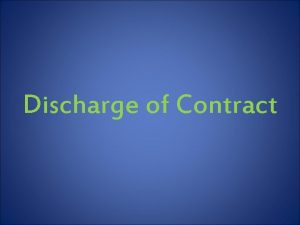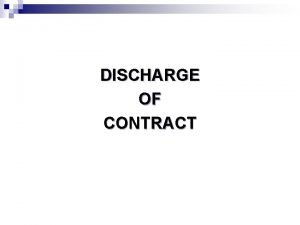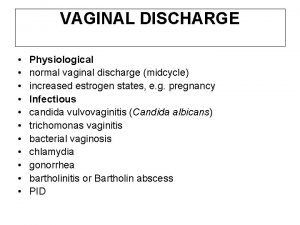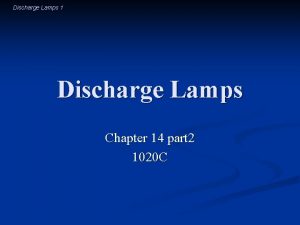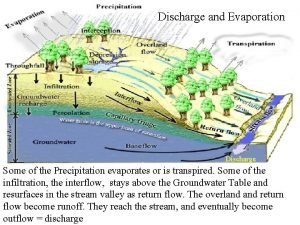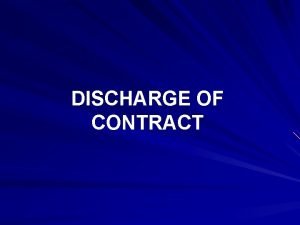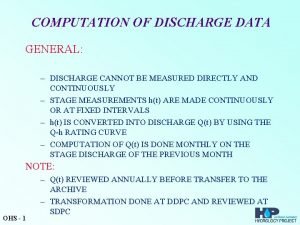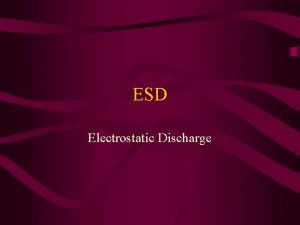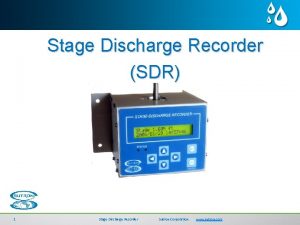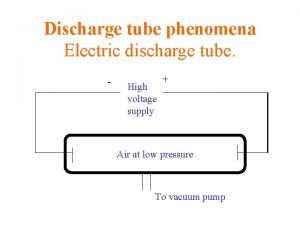Lecture 7 1 The condition of self discharge

























- Slides: 25

Lecture № 7. 1. The condition of self discharge. 2. Paschen curves. 3. Time of discharge. 4. Gas breakdown in a nonuniform electric field. 5. The emergence and development of streamers 1

1. The condition of independence of the discharge. The flow of electrons generated in the gas gap by one electron, called an electron avalanche Scheme of the electron avalanche 2

The first Townsend coefficient α - the number of ionization electrons on the path of 1 cm Impact ionization coefficient α – product number of collisions of Z = 1 / λ on the way to 1 cm on the probability of impact ionization on the mean free path : 3

Electronic component of the discharge current is defined as . Since the total current carried by electrons at the anode, then it will have the following relationship: . 4

Influence of secondary electron emission on increasing the current in the discharge gap length d (air, p = 200 Torr). 5

For the emergence of self-discharge is necessary to start an avalanche occurs spontaneously provided by secondary processes associated with its development, the emergence of the cathode of at least one new ("secondary") of an electron, causing a secondary avalanche. Mechanisms of secondary emission: - release of electrons from the cathode by bombarding the surface primary avalanche positive ions (the second coefficient. Townsend) - photoemission from the cathode surface, carried out by radiation of an avalanche - the appearance of new electrons in the volume of gas (by the associative ionization photoionization). Nel = Neu+ Nеf+Nеfи+ …. = γN+ γ - generalized secondary ionization coefficient. 6

The condition of independence of the discharge : Nel>1 or γ·N+>1 Given that , N+ = e α·d -1, condition for the transition into an independent non-self-discharge can be written as: 7

The dependence of current density on the electric field I. The region of weak fields. II. The area of impact ionization. III. The discharge region. 8

2. Paschen law Paschen curve for air Gas Ne Аr H 2 Air (p·d)min. cm·Torr 4 1. 7 1 0. 5 U, В 240 270 300 350 9

Uпр = E пр·d The solution of these equations: 10

Paschen curve for air 11

The coefficient of impact ionization α is the product of: number of collisions of Z = 1 / λ on the way to 1 cm the probability of impact ionization on the mean free path: Dependence on gas pressure of electron collisions with molecules of (1), the probability of 12 ionization of the molecule (2) and the coefficient of impact ionization (3).

Deviations from the Paschen's law 1. In the high-pressure 2. In small gaps 3. At high overpotentials (in a pulsed discharge) Dependence of the breakdown of nitrogen pressure on the pressure. 13

3. Discharge time The discharge time is defined as the time elapsed from the instant the voltage across the electrodes the static breakdown voltage until the formation of the electrode conductive path. At the time of discharge tр distinguish two components: • statistical time lag tcm • the formation time of discharge tf t. Р = tst + tf. Discharge formation time - this time from the onset “effective" until the formation of an electron between the electrodes conductive path. 14

The statistical time lag - the time from the instant the voltage across the electrodes the static breakdown voltage before the "efficient" electron. The dependence of the statistical time lag of the voltage across the spark gap The dependence of the minimum statistical time lag of the work function of electrons from the cathode 15

4. Gas breakdown in a nonuniform electric field. Education effective electron Developmente avalanche The ion current the cathode Secondary emission electron ·[exp( · d) 1] 16

Secondary avalanches develop in the gap where there is uncompensated charge of the ions from previous avalanches. Suppose as a result of the previous series of avalanche generation near anode accumulated space charge of positive ions. It is uniformly distributed in the area d 1 d. Cathode Anode 17

Cathode Anode Electron avalanche develops a number in the effective interelectrode interval length d 1 in electrical field E 1 The number of electrons in this avalanche where N 0 – the initial number of electrons at the cathode. The number of ions in the avalanche Electron avalanche number 2 will be developed in an electric field effective electrode gap d 2. The number of ions in it is given by where N 0[exp( 1 d 1) 1] – the initial number of electrons at the cathode in the second 18 avalanche.

Cathode Anode On the one hand, d 2 d 1, and this factor leads to a reduction factor . On the other hand, 2 > 1 , that should increase . Between the cathode surface and the edge of the emission region exists area of the cathode potential drop. The role of this region is due to impact ionization strengthen the weak electron current from the cathode to a value equal electron current in the plasma. 19

5. The emergence and development of streamers The rate of electron avalanche in air at normal pressure and at E = 30 k. V / cm is of the order 107 сm/s. By increasing the pulse duration or amplitude were found: -new ionization education, occupying a large volume and -propagating at high speed. Photos of the ionization processes, obtained by ionization chamber. 20

+ - Schematic of the ionization chamber device: 1 - electrodes; 2 - glass cylinder; 3 - diaphragm; 4 - auxiliary spark gap; 5 - quartz glass. 21

Streamer, which develops in the direction of the cathode, was named positive. Velocity of propagation in air is (1 2) 108 cm/s. Streamer, which continues to evolve in the direction of the electron avalanche, was called negative, and its propagation velocity in the air was (7 8) 107 cm/s After propagation of streamers in all the interelectrode gap place the full sample. 22

Positive streamer The main factors determining the emergence and development of the streamer: - electric field generated by the charges of the electron avalanche - electrons appearing as a result of photoionization - photoelectrons. Scheme of development of a positive streamer: 1 - electron avalanche; 2 - left the avalanche space charge; 3 - photoelectrons; 4 - conducting plasma 23

Negative streamer Diagram of the negative streamer: 1 - electron avalanche; 2 - electromagnetic radiation (photons); 3 - photoelectron. 24

Condition for the occurrence and distribution of both positive and negative streamers can be written as E 1 = k·Еср. where the coefficient k varies widely (k = 0, 5 1). The meaning of this condition reduces to the fact that the field strength created by space charges should be comparable in magnitude with the intensity the main field. 25
 Differentiate between real self and ideal self
Differentiate between real self and ideal self Gd&t symbol
Gd&t symbol 01:640:244 lecture notes - lecture 15: plat, idah, farad
01:640:244 lecture notes - lecture 15: plat, idah, farad Thế nào là mạng điện lắp đặt kiểu nổi
Thế nào là mạng điện lắp đặt kiểu nổi Thế nào là hệ số cao nhất
Thế nào là hệ số cao nhất Lời thề hippocrates
Lời thề hippocrates Frameset trong html5
Frameset trong html5 đại từ thay thế
đại từ thay thế Vẽ hình chiếu đứng bằng cạnh của vật thể
Vẽ hình chiếu đứng bằng cạnh của vật thể Quá trình desamine hóa có thể tạo ra
Quá trình desamine hóa có thể tạo ra Khi nào hổ mẹ dạy hổ con săn mồi
Khi nào hổ mẹ dạy hổ con săn mồi Tư thế worm breton là gì
Tư thế worm breton là gì Các loại đột biến cấu trúc nhiễm sắc thể
Các loại đột biến cấu trúc nhiễm sắc thể Nguyên nhân của sự mỏi cơ sinh 8
Nguyên nhân của sự mỏi cơ sinh 8 Phản ứng thế ankan
Phản ứng thế ankan Các châu lục và đại dương trên thế giới
Các châu lục và đại dương trên thế giới Thiếu nhi thế giới liên hoan
Thiếu nhi thế giới liên hoan Fecboak
Fecboak Bổ thể
Bổ thể điện thế nghỉ
điện thế nghỉ Một số thể thơ truyền thống
Một số thể thơ truyền thống Hệ hô hấp
Hệ hô hấp So nguyen to
So nguyen to Chúa yêu trần thế
Chúa yêu trần thế đặc điểm cơ thể của người tối cổ
đặc điểm cơ thể của người tối cổ Các châu lục và đại dương trên thế giới
Các châu lục và đại dương trên thế giới


























